-
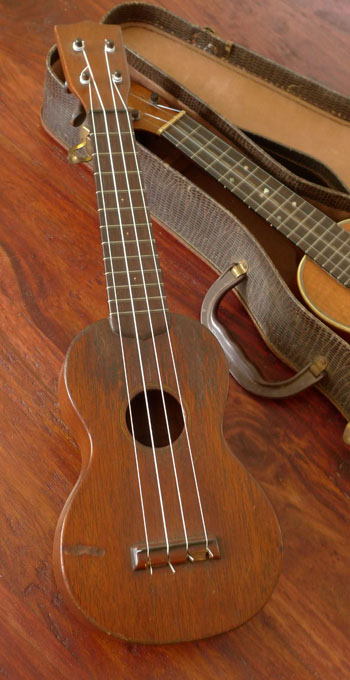 A pre-decal Uke from Martin. Style 0, with no body binding. Well worn, but 100% crack free.
A pre-decal Uke from Martin. Style 0, with no body binding. Well worn, but 100% crack free. -
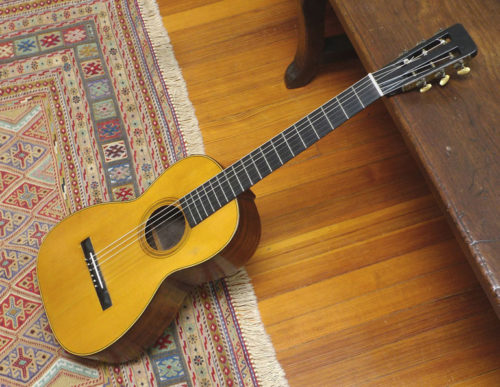 This guitar is the last known guitar in existence, made by Louis Schmidt, the famous contemporary and one-time colleague to the founder of Martin Guitars, the original C.F. Martin. As such, it is a rare example of early American guitar making. And it’s signed by the maker, on the underside of the Adirondack top: Louis Schmidt Wakefield Westchester Cy NY July 9th 1859 U.S. Louis Schmidt worked side by side with CF Martin in the early years. Perhaps the most common misconception about early American guitar history is that C. F. Martin spent his first years in America earning a living as a solitary luthier in his New York workshop. Pay ledgers reveal that as early as 1834 he was paying luthiers to help him make his guitars. Two of these men, Heinrich Schatz and Louis Schmidt, left Martin's employ to make guitars on their own, and each succeeded as top builders. This instrument:
This guitar is the last known guitar in existence, made by Louis Schmidt, the famous contemporary and one-time colleague to the founder of Martin Guitars, the original C.F. Martin. As such, it is a rare example of early American guitar making. And it’s signed by the maker, on the underside of the Adirondack top: Louis Schmidt Wakefield Westchester Cy NY July 9th 1859 U.S. Louis Schmidt worked side by side with CF Martin in the early years. Perhaps the most common misconception about early American guitar history is that C. F. Martin spent his first years in America earning a living as a solitary luthier in his New York workshop. Pay ledgers reveal that as early as 1834 he was paying luthiers to help him make his guitars. Two of these men, Heinrich Schatz and Louis Schmidt, left Martin's employ to make guitars on their own, and each succeeded as top builders. This instrument:- Similar features to circa 1860 Martin 17 style... but different purfling, binding, and slightly different body shape
- All original finish
- Brazilian rosewood back and sides (solid); Adirondack top
- In its original coffin case
- 11 3/8 inches wide at lower bout (a bit larger than a Martin 2 1/2)
- Body: 3 7/8 inches deep
- Original mahogany bridge plate (goes almost all the way across the width of the top, slotted under all the braces)
- Fan bracing pattern
- Plays beautifully. Good bass tone. Action is perfect.
- Ebony Bridge has been off at some point, and reglued on. With a lack of similar guitars on the market, it’s not known if this 19th century bridge on the instrument is the original bridge.
- One repaired crack on top, from bridge to bottom binding; One repaired crack on back. One small crack on top, either top edge of soundhole.
- Original Jerome tuners, reverse gear, working perfectly
- Maple and rosewood purfling/binding on top (no binding on back)
-
 Nothing sounds like a 30’s Gibson L-00. No longer a sleeper on the vintage guitar market–they are sought after by working musicians the world over¬–they are still under-rated on the collector market. These mid-size Gibsons are incredibly resonant. There is nothing like them, from Gibson, and the mid-size Adirondack spruce over mahogany Martins from the mid to late 30’s command more than twice the price. This L-00 from 1938 has the best tone of any of the 30’s L-00’s we’ve seen. You won’t believe its presence. Acquired by us from the family of the original owner in Austin, Texas, this guitar is a great example of the era when Gibson still had a production jump on Martin, and even its lower cost guitars were winning the marketing war at the trailing end of the depression. This L-00 had a re-spray of its burst in the early 60’s, so while not the original finish, it’s got the right look and feel of the 30’s, and plenty of mileage to make it more than convincing. The top and sides are completely crack-free, and there are only two small cracks on the back. One is not through the wood, and the other was expertly addressed by Tony Nobles with a small cleat. Tony also made a new perfect reproduction Brazilian Rosewood bridge. The bridge plate is original and in great condition. Original firestripe pickguard. Original nut. The non-original tuners on the instrument when we acquired it were replaced by us with klusons from the period. Tony also installed new T-frets. While we tend to specialize in vintage Martins, this one might change my mind.
Nothing sounds like a 30’s Gibson L-00. No longer a sleeper on the vintage guitar market–they are sought after by working musicians the world over¬–they are still under-rated on the collector market. These mid-size Gibsons are incredibly resonant. There is nothing like them, from Gibson, and the mid-size Adirondack spruce over mahogany Martins from the mid to late 30’s command more than twice the price. This L-00 from 1938 has the best tone of any of the 30’s L-00’s we’ve seen. You won’t believe its presence. Acquired by us from the family of the original owner in Austin, Texas, this guitar is a great example of the era when Gibson still had a production jump on Martin, and even its lower cost guitars were winning the marketing war at the trailing end of the depression. This L-00 had a re-spray of its burst in the early 60’s, so while not the original finish, it’s got the right look and feel of the 30’s, and plenty of mileage to make it more than convincing. The top and sides are completely crack-free, and there are only two small cracks on the back. One is not through the wood, and the other was expertly addressed by Tony Nobles with a small cleat. Tony also made a new perfect reproduction Brazilian Rosewood bridge. The bridge plate is original and in great condition. Original firestripe pickguard. Original nut. The non-original tuners on the instrument when we acquired it were replaced by us with klusons from the period. Tony also installed new T-frets. While we tend to specialize in vintage Martins, this one might change my mind. -
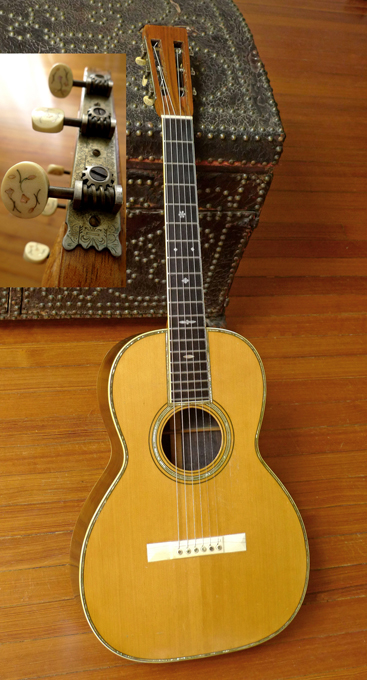 Exquisite, and a joy to play (… the top level, largest guitar that Martin made at the turn of the 20th century– with tone that shows off what Frank Henry Martin was proud of when he personally signed the inside of this instrument in April, 1903…)
Exquisite, and a joy to play (… the top level, largest guitar that Martin made at the turn of the 20th century– with tone that shows off what Frank Henry Martin was proud of when he personally signed the inside of this instrument in April, 1903…) -
 This fine Brazilian Rosewood 12-fret Martin is a joy to play, and it’s properly set up for steel strings. The grandson of C. F. Martin, Sr., Frank Henry Martin oversaw the Martin business from 1880 until well into twentieth century, and was responsible for the creation of the Style 0. I’m sure he loved this guitar–he personally signed the instrument, in cursive, under the top: “# 10082 Oct. 17th, 1905 F.H.M.” This 0-21 combines the exquisite tone of a 100 year old Martin, with some wonderful restoration. Guitar was refinished, probably decades ago, and it is a beautiful, French polish finish that has all the earmarks of an original finish. You can see the pores and saw marks in the Brazilian rosewood. No heavy-handed finish here, it’s a natural finish that lets the grain and color of the wood come through. And the tone, too, that sweet tone you can only get from Brazilian this old. The ebony pyramid bridge is a replacement, and features a compensated saddle, so intonation is dead on. (The bridge plate is the original small maple plate, in perfect condition.) Original tuners. Crack-free top and sides. There is only one very small crack, on the back, about 3 inches long, professionally repaired. The neck was set recently by Tony Nobles, and the original bar frets dressed. It plays, and sounds, like a late 20’s 12-fret Brazilian rosewood Martin.
This fine Brazilian Rosewood 12-fret Martin is a joy to play, and it’s properly set up for steel strings. The grandson of C. F. Martin, Sr., Frank Henry Martin oversaw the Martin business from 1880 until well into twentieth century, and was responsible for the creation of the Style 0. I’m sure he loved this guitar–he personally signed the instrument, in cursive, under the top: “# 10082 Oct. 17th, 1905 F.H.M.” This 0-21 combines the exquisite tone of a 100 year old Martin, with some wonderful restoration. Guitar was refinished, probably decades ago, and it is a beautiful, French polish finish that has all the earmarks of an original finish. You can see the pores and saw marks in the Brazilian rosewood. No heavy-handed finish here, it’s a natural finish that lets the grain and color of the wood come through. And the tone, too, that sweet tone you can only get from Brazilian this old. The ebony pyramid bridge is a replacement, and features a compensated saddle, so intonation is dead on. (The bridge plate is the original small maple plate, in perfect condition.) Original tuners. Crack-free top and sides. There is only one very small crack, on the back, about 3 inches long, professionally repaired. The neck was set recently by Tony Nobles, and the original bar frets dressed. It plays, and sounds, like a late 20’s 12-fret Brazilian rosewood Martin. -
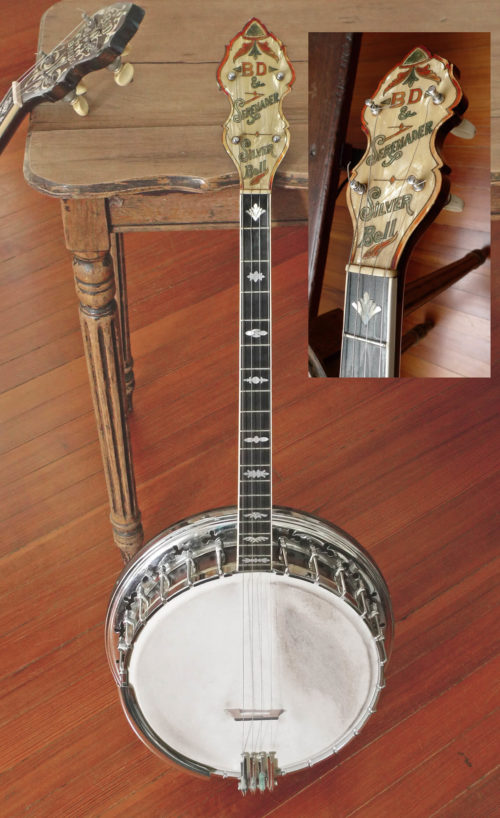 This 1922 Bacon & Day Serenader, tenor banjo is in great original condition. The well-worn head can be easily replaced– we retained it for originality. The banjo shows little wear. And all the parts are original–Tailpiece, tuners, dowel, everything. This is a golden era B&D, not one of the later 30s/40's banjos that are more common. In this condition it is rare. And it comes in its original hard shell case. Price: $1695.
This 1922 Bacon & Day Serenader, tenor banjo is in great original condition. The well-worn head can be easily replaced– we retained it for originality. The banjo shows little wear. And all the parts are original–Tailpiece, tuners, dowel, everything. This is a golden era B&D, not one of the later 30s/40's banjos that are more common. In this condition it is rare. And it comes in its original hard shell case. Price: $1695. -
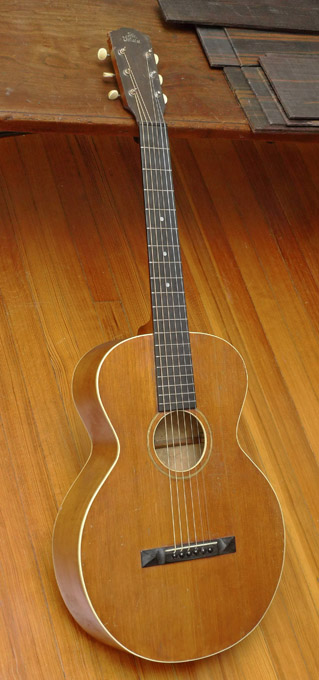 This historically significant Gibson L-1, 12-fret flat top guitar, is the earliest true Gibson flat top guitar on the market today. As well as the one in the best, original condition. And it is a rare example, exhibiting transitional features that place it just barely after the 1926 introduction– yet still a 1926 model (Factory order number: 8406)– but leaning toward a few subsequent, very early changes that would establish Gibson on the flat top scene that Martin had carved out so well. Introduced in '26 (there was already a L-1 archtop), the original Gibson L-1 flat top had a 13-1/2" body, wide V-neck, and H-bracing. The L-1 later achieved fame due to its association with the legendary bluesman Robert Johnson. Its rounded lower bout, combined with narrow waist, is distinctive. And its thin braces, thin finish, and thin woods give it a wonderful woody yet loud, cutting, bluesy tone that no 1930’s– much less more modern– Gibson or Martin could achieve. It is the transitional nature of this particular guitar, that is intriguing. The very first L-1 flat top, had an arched back (birch, or maple), and a pretty fat V-shaped neck. Other traits of the very first L-1 flat top: single bound top; maple back and sides; no truss rod; unbound ebony fingerboard; H pattern top bracing; “The Gibson” paint logo straight across peghead; light amber top finish; Sheraton brown finish on back and sides; single bound back. But this L-1, though very early, does not have arched back, but rather a true flat top-style back. And its neck is a great-playing C shape, not overly fat, and not a V shape. Furthermore, it has “A” bracing, not the standard H bracing. Finally, this guitar has a (original) ebony fretboard with virtually no radius. It’s a true “transition” example. It is notably not a hybrid put together from old L-1 archtop parts– as were the very first L-1 “flat tops” out of the gate in 1926. These are the traits of this early Gibson L-1 flat top:
This historically significant Gibson L-1, 12-fret flat top guitar, is the earliest true Gibson flat top guitar on the market today. As well as the one in the best, original condition. And it is a rare example, exhibiting transitional features that place it just barely after the 1926 introduction– yet still a 1926 model (Factory order number: 8406)– but leaning toward a few subsequent, very early changes that would establish Gibson on the flat top scene that Martin had carved out so well. Introduced in '26 (there was already a L-1 archtop), the original Gibson L-1 flat top had a 13-1/2" body, wide V-neck, and H-bracing. The L-1 later achieved fame due to its association with the legendary bluesman Robert Johnson. Its rounded lower bout, combined with narrow waist, is distinctive. And its thin braces, thin finish, and thin woods give it a wonderful woody yet loud, cutting, bluesy tone that no 1930’s– much less more modern– Gibson or Martin could achieve. It is the transitional nature of this particular guitar, that is intriguing. The very first L-1 flat top, had an arched back (birch, or maple), and a pretty fat V-shaped neck. Other traits of the very first L-1 flat top: single bound top; maple back and sides; no truss rod; unbound ebony fingerboard; H pattern top bracing; “The Gibson” paint logo straight across peghead; light amber top finish; Sheraton brown finish on back and sides; single bound back. But this L-1, though very early, does not have arched back, but rather a true flat top-style back. And its neck is a great-playing C shape, not overly fat, and not a V shape. Furthermore, it has “A” bracing, not the standard H bracing. Finally, this guitar has a (original) ebony fretboard with virtually no radius. It’s a true “transition” example. It is notably not a hybrid put together from old L-1 archtop parts– as were the very first L-1 “flat tops” out of the gate in 1926. These are the traits of this early Gibson L-1 flat top:- Single bound, red spruce top, with amber stain
- Original ebony bridge; original cellulose bridge pins (unslotted)
- Maple back and sides (back is not arched), with Sheraton brown finish
- Mahogany neck, C-shaped
- Original, very thin maple bridge plate, tucked under braces, and extending all the way to the kerfing at the sides of the top, and tucked under the Kerfing
- No truss rod
- Unbound ebony fingerboard (not “ebonized”, but solid ebony)
- “The Gibson” paint logo straight across peghead
- Single bound (ivoroid) top
- Single bound (ivoroid) back
- H bracing (a slight variation of “A” bracing; with the apex at either side of the neck block– and the braces actually tuck beneath the neck block)
- Pearl dots on 5,7, and 9 frets
- Original three-on-a-plate tuners, with plastic tuner buttons
- Original frets
- Original ebony nut
- 13 5/8 inch, lower bout
- 24 1/2 inch scale (not the 25 inch scale that was soon settled on by Gibson for the L-1, soon after the introduction)
- Nut width: just shy of 1 7/8 inch
- Width of fretboard at 12th fret: 2 ¼ inch
- String spacing at nut: a hair over 1 ½ inch
- String spacing at bridge: 2 3/8 inch
- Three well-repaired top cracks (all, with the grain; and the amber finish on top is very forgiving, in terms of appearance, so cracks are hardly visible)
- One replaced tuner post
-
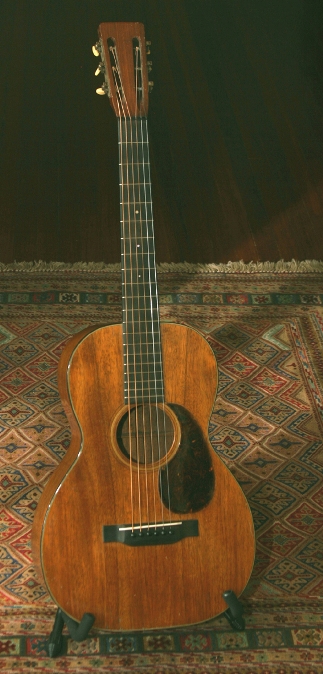 We converted this Golden Era 12-fret Koa Martin from the original Hawaiian setup ourselves, so it's perfect. The instrument does not have a crack anywhere. All original finish. Original Ebony bridge, converted from the tall Hawaiian set-up to a normal 30's set-up. Same with the ebony nut. All new, period-perfect Bar Frets. We radiused the ebony fretboard to 30's Martin specs. Neck was set and action is perfect. 1-7/8 inch nut width. Original tuners. Original bridge plate. Minor nicks and dings on top and back, but with the all original finish and crack-free, it's a rare specimen. Nothing compares in tone to an all-Koa Golden Age Martin. Koa blends the midrange of mahogany with the top end of maple-or, in the case of a fine 30's Koa Martin- hints of Brazilian rosewood. This fine 0-18K has all you would want from a Koa Martin, with the clearest, bell-like treble string tone imaginable.
We converted this Golden Era 12-fret Koa Martin from the original Hawaiian setup ourselves, so it's perfect. The instrument does not have a crack anywhere. All original finish. Original Ebony bridge, converted from the tall Hawaiian set-up to a normal 30's set-up. Same with the ebony nut. All new, period-perfect Bar Frets. We radiused the ebony fretboard to 30's Martin specs. Neck was set and action is perfect. 1-7/8 inch nut width. Original tuners. Original bridge plate. Minor nicks and dings on top and back, but with the all original finish and crack-free, it's a rare specimen. Nothing compares in tone to an all-Koa Golden Age Martin. Koa blends the midrange of mahogany with the top end of maple-or, in the case of a fine 30's Koa Martin- hints of Brazilian rosewood. This fine 0-18K has all you would want from a Koa Martin, with the clearest, bell-like treble string tone imaginable. -
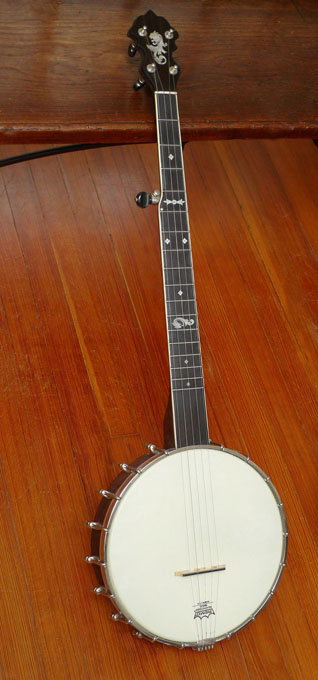 This is a one-of-a-kind custom banjo, from one of the country’s most respected luthiers, based in Appomattox, Virginia. I love this banjo for picking on the couch– it won’t put your back out, picking it up and putting it down, or crush your cat or your sweetheart. It’s lightweight, and with a custom-size head. But it packs beautiful full tone, not the tinny nasal sound from most open back banjos. It’s five or so years old, but with very little wear.
This is a one-of-a-kind custom banjo, from one of the country’s most respected luthiers, based in Appomattox, Virginia. I love this banjo for picking on the couch– it won’t put your back out, picking it up and putting it down, or crush your cat or your sweetheart. It’s lightweight, and with a custom-size head. But it packs beautiful full tone, not the tinny nasal sound from most open back banjos. It’s five or so years old, but with very little wear.- Dark stained maple rim, and neck
- 11 inch pot
- Ebony fretboard
- Engraved dragon inlay in peghead
- Custom MOP inlays
- Bound neck
- No Knot tail piece (Pat. Nov. 19 1901)
- 18 lug
- Brass hoop tone ring
- Dowell stick construction
- nut width 1-¼ inch
- scale: 25- ½ inches
- maple rim diameter: 10- ½ outside
- maple rim thickness: 7/16 inches
- Dark stained maple rim, and neck
- 11 inch pot
- Ebony fretboard
- Engraved dragon inlay in peghead
- Custom MOP inlays
- Bound neck
- No Knot tail piece (Pat. Nov. 19 1901)
- 18 lug
- Brass hoop tone ring
- Dowell stick construction
- nut width 1-¼ inch
- scale: 25-½ inches
- maple rim diameter: 10- ½ outside
- maple rim thickness: 7/16 inches
- With original case.
-
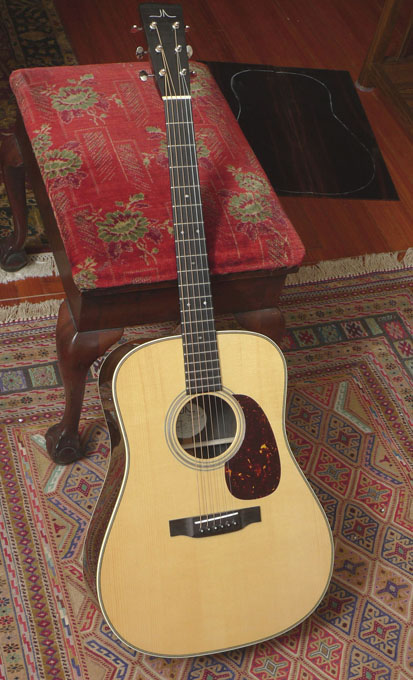 This is a new Allison Brazilian Rosewood dreadnought. Austin-based John Allison was a key part of the Collings Guitar team for years. John is now one of the most sought-after independent makers of fine instruments in the southwest. His guitars are carried by a number of top dealers in the U.S… and we’ve just snagged this brand new, wonderful Brazilian– a custom order guitar. Allison’s attention to detail is astounding. You just have to see and play this great brazilian. Right off the bench, it’s loud and beguiling, and it will only get better over time.
This is a new Allison Brazilian Rosewood dreadnought. Austin-based John Allison was a key part of the Collings Guitar team for years. John is now one of the most sought-after independent makers of fine instruments in the southwest. His guitars are carried by a number of top dealers in the U.S… and we’ve just snagged this brand new, wonderful Brazilian– a custom order guitar. Allison’s attention to detail is astounding. You just have to see and play this great brazilian. Right off the bench, it’s loud and beguiling, and it will only get better over time.- Top: Adirondack Spruce
- Back, and Sides: Brazilian Rosewood
- Bracing: Scalloped X, Adirondack
- Neck: Mahogany
- Finish: Nitrocellulose lacquer
- Herringbone purfling
- Ivoroid binding
- Fretboard: Ebony
- Bridge: Ebony
- Peghead veneer: Ebony
- Scale Length: 25.5 inches
- Nut Width: 1 11/16 inches
- Tuners: Waverly
-
 The Larson Brothers of Chicago never marketed any guitar, throughout their long career, that was marked “Larson”. Their designs were branded by Maurer, Stahl, Prarie State, Stetson, and a few other guitar makers– but never “Larson”. They were also known for making many “off-catalog” guitars, i.e. guitars with combinations of features that varied from the Maurer, Stahl, etc, catalogs, and guitars that were not marked at all with a brand. This guitar is a Larson Bros creation that is not marked at all. It is a custom made instrument–but it has all the typical Larson hallmarks. The tone of this Larson is every bit as wonderful as the Maurer/Larson listed above, indeed it is quite similar, due to the same patented “built under tension” design, and X-bracing. This Larson does not have laminated braces (it’s well documented that laminated braces were only used on certain models–and their use was not related to level or price.) Every part of this guitar is original, including original finish. There are two repaired cracks on the back, and three small, repaired cracks on top.
The Larson Brothers of Chicago never marketed any guitar, throughout their long career, that was marked “Larson”. Their designs were branded by Maurer, Stahl, Prarie State, Stetson, and a few other guitar makers– but never “Larson”. They were also known for making many “off-catalog” guitars, i.e. guitars with combinations of features that varied from the Maurer, Stahl, etc, catalogs, and guitars that were not marked at all with a brand. This guitar is a Larson Bros creation that is not marked at all. It is a custom made instrument–but it has all the typical Larson hallmarks. The tone of this Larson is every bit as wonderful as the Maurer/Larson listed above, indeed it is quite similar, due to the same patented “built under tension” design, and X-bracing. This Larson does not have laminated braces (it’s well documented that laminated braces were only used on certain models–and their use was not related to level or price.) Every part of this guitar is original, including original finish. There are two repaired cracks on the back, and three small, repaired cracks on top.- Lower bout width: 12 5/8 inches
- Brazilian rosewood back and sides
- Ivory celluloid Bound fretboard
- Ivory celluloid Bound headstock
- Spruce top
- X braced
- Larson’s patented “built under tension” design
- Rosette: Abalone pearl and wood inlay bordering the sound hole
- Radiused ebony fingerboard, and Classic Larson Brothers’ “ebony below the binding”
- Engraved inlays on fretboard
- Original tuners
- Original ebony bridge
- Original bridge pins
- 1-7/8" wide nut
- 2 1/4" bridge string spacing
- 24.3" scale length
- One-piece mahogany neck, round C shaped neck profile.
-
 When this concert guitar was made in 1976, it was the top model offered by the master luthier Masaru Kohno– when he was at the very height of his career. There is some confusion out there as to which Kohno was the “top” concert model at any given date in height of Masaru Kohno’s career– from the early 70’s to the late-80s’. No confusion here– as there is correspondence (from August 2011) directly from Masaki Sakurai to us, regarding this guitar. Masaki Sakurai (nephew of Masaru Kohno, who in fact worked along side Masaru Kohno when this instrument was made in 1976, and now of course runs the “Sakurai/Kohno” shop, since the death of Masaru Kohno in 1998) confirms that this guitar was the top model available from Kohno in mid-1976. (Don’t be confused– a later, for example 1980 No. 30 Kohno is not a top Kohno model from that year. By 1980, the top model was a No. 50.) The confusion arises because Kohno had, in the early 70s until the late 80’s the custom of making his model numbers correspond to the guitars’ price in Japanese Yen. Hence, this guitar, a “No. 30”, in mid-1976, was priced at 300,000 Japanese Yen, and was the top model (a very expensive guitar in 1976). The confusion arises because as the inflation-prone 70’s continued, everyone adjusted prices upward. When inflation kept advancing, Kohno model numbers were something of a moving target, and the “top model” number changed upwards over time. Over time the top model moved up to No. 30 (this guitar), and then later No. 50 (starting in 1977). Kohno finally stopped using numbers in the 80’s and then called the top model the “Professional J”, and on, with more variations of “Professional”.) In any case this guitar, was the top model made, when it came from the Kohno shop (correspondence from Masaki Sakurai confirming this, will be supplied). But the real proof is in the playing. This instrument stands along with the best brazilian rosewood/spruce concert guitars from any maker, anywhere, any period. Crystal clear brazilian trebles. Wonderful resonance, combined with superior string separation.
When this concert guitar was made in 1976, it was the top model offered by the master luthier Masaru Kohno– when he was at the very height of his career. There is some confusion out there as to which Kohno was the “top” concert model at any given date in height of Masaru Kohno’s career– from the early 70’s to the late-80s’. No confusion here– as there is correspondence (from August 2011) directly from Masaki Sakurai to us, regarding this guitar. Masaki Sakurai (nephew of Masaru Kohno, who in fact worked along side Masaru Kohno when this instrument was made in 1976, and now of course runs the “Sakurai/Kohno” shop, since the death of Masaru Kohno in 1998) confirms that this guitar was the top model available from Kohno in mid-1976. (Don’t be confused– a later, for example 1980 No. 30 Kohno is not a top Kohno model from that year. By 1980, the top model was a No. 50.) The confusion arises because Kohno had, in the early 70s until the late 80’s the custom of making his model numbers correspond to the guitars’ price in Japanese Yen. Hence, this guitar, a “No. 30”, in mid-1976, was priced at 300,000 Japanese Yen, and was the top model (a very expensive guitar in 1976). The confusion arises because as the inflation-prone 70’s continued, everyone adjusted prices upward. When inflation kept advancing, Kohno model numbers were something of a moving target, and the “top model” number changed upwards over time. Over time the top model moved up to No. 30 (this guitar), and then later No. 50 (starting in 1977). Kohno finally stopped using numbers in the 80’s and then called the top model the “Professional J”, and on, with more variations of “Professional”.) In any case this guitar, was the top model made, when it came from the Kohno shop (correspondence from Masaki Sakurai confirming this, will be supplied). But the real proof is in the playing. This instrument stands along with the best brazilian rosewood/spruce concert guitars from any maker, anywhere, any period. Crystal clear brazilian trebles. Wonderful resonance, combined with superior string separation.- Hand-signed on label by Masaru Kohno, and dated 1976
- Solid European spruce top
- Solid Brazilian rosewood back and sides
- 660mm scale length
- Nut: 52mm
- Mahogany neck with 2 ebony supporting strips
- Ebony fretboard
- Gold engraved Gotoh tuners
- One repaired crack on back of guitar
- Crack-free top and sides. There are various nicks, dings, and scratches.
- Finish is naturally worn off, through playing, on the center section of the back of the neck– giving it a very fast feel in the left hand.